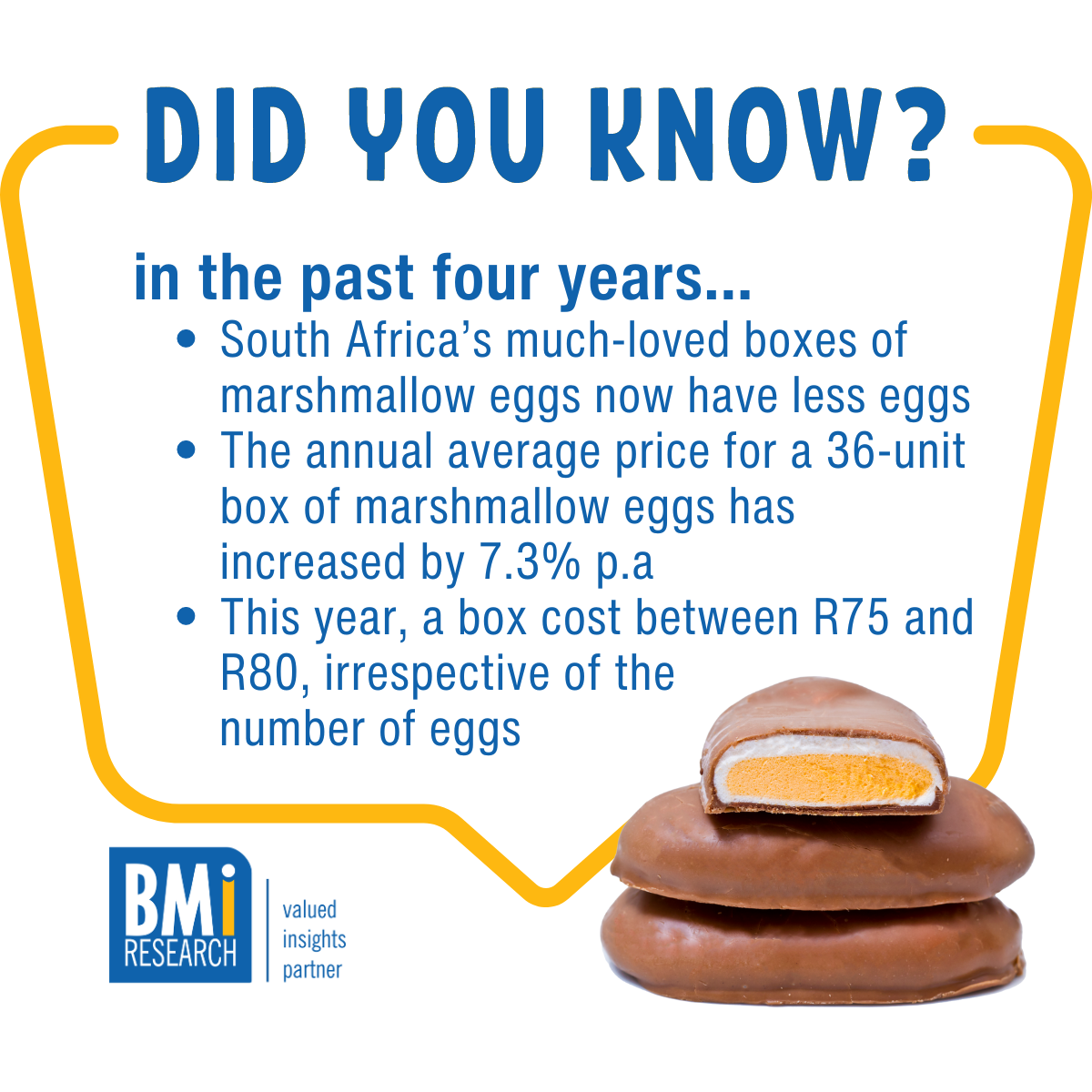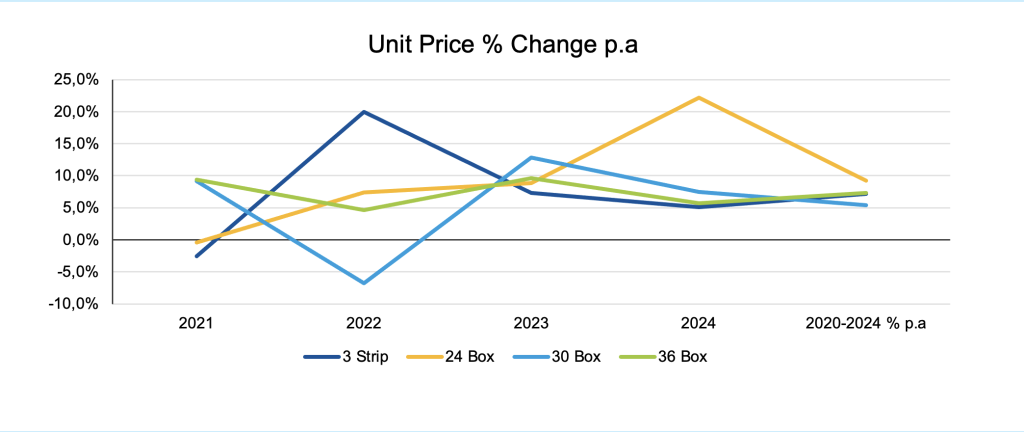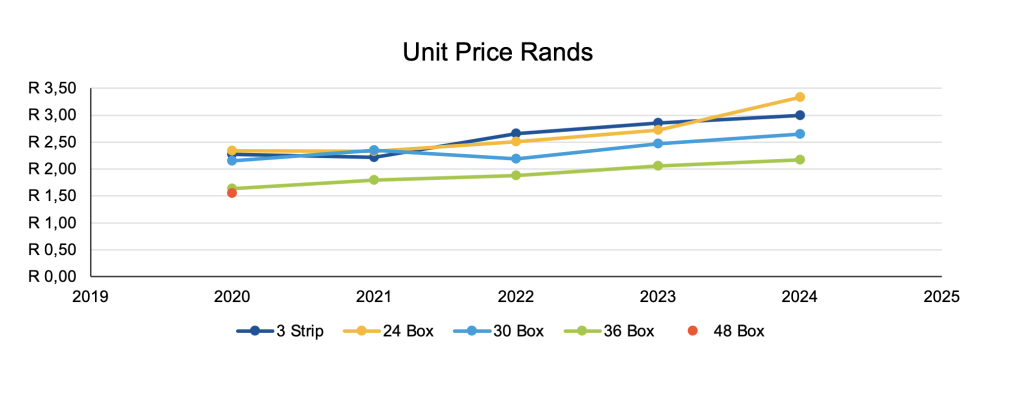
Shrinkflation hits SA’s beloved marshmallow Easter eggs
Chocolate marshmallow eggs have long been a favourite in South African households. They’ve become part of Easter traditions and are seen as an affordable treat to give to children.
But over the years something has changed with our much-loved marshmallow eggs: the boxes have gotten smaller.
Where did the 48-unit box of eggs go?
Previously, a standard size marshmallow egg box contained 48 units. Over the years manufacturers have introduced boxes with 36, 30 and most recently, 24 units. The 48-unit box now seems to be something of the past.
The reason for this can be found in the pricing of these boxes. In 2024, a 36-unit box of eggs from a well-known brand cost R78.29. In previous years it cost R74.06 (2023), R67.84 (2022), R65.34 (2021) and R59.99 (2020). That represents an annual average price increase over four years of 7.3% pa. Applying that same increase to the price of a box of 48 units from the same brand, which retailed for R75.19 in 2020, would put the price for this box today at more than R100.
For an average family, in today’s economy, a treat that costs more than R100 would be perceived as being unaffordable, and so the 48-unit box has been gradually phased out.
The result is that the remaining size boxes are seen as being more affordable. But are they really offering good value?
When you compare the price of 36-unit boxes to 30- and 24-unit boxes, the 36-unit box is the cheapest per egg and the 24-unit box, the most expensive. That makes sense, as when you buy in bulk you save.


Smaller pack sizes more visible
However, research conducted by BMi Research during this Easter period showed that the 36-unit boxes were not as visible on shelf this year. They were available in seemingly limited amounts, and consumers had to search for them. The smaller pack sizes of 30 and 24 units were highly visible and readily available.
This tells us that manufacturers are putting most of their marshmallow egg stock into smaller size boxes, which retail at higher prices, and the smaller chunk of their stock into the 36-unit box, which may also be in the process of being phased out.
Consumers might not be aware that the different size boxes carry different price tags, and when comparing them on shelf could easily mistake a cheaper product for offering better value, only to find once home that it actually has less units.
Naturally, the price per egg has also changed over the past four years, by an average of 9.2% pa (24-unit box), 5.4% pa (30-unit box) and 7.3% pa (36-unit box). Consumers are currently paying between R2.15 and R3.50 for an individual egg, depending on the box size. These increases are significantly above inflation.
Larger boxes offer greater value
When comparing the boxes based on these per unit prices, the research shows that a 30-unit box is on average 20% more expensive per egg, than a 36-unit box, while the 24-unit box egg is on average 50% more expensive than an egg from a box of 36 eggs. Once again, this points to the 36-unit box offering the most value, yet its availability in the foreseeable future is questionable. This will leave consumers having to buy smaller boxes of eggs at higher prices.
We could assume that R100 for a box of marshmallow eggs is a psychological price point that manufacturers would want to avoid. This would account for our findings that all the boxes priced during this research were between R74.99 and R79.99.
Shrinkflation, not high cocoa costs, to blame
This phenomenon reflects the growing trend towards shrinkflation, where manufacturers decrease the size of individual units or product packs to ensure that the price stays at ‘comfortable’ consumer price points.
The recent global price hikes in the cost of cocoa, the raw material used to produce chocolate, has been cited in the press as a primary reason for the increase in the cost of chocolate bars and countlines this year.
However, while our research did not ascertain whether or not the unit size of individual eggs had changed over the past four years, we did note that the chocolate shell was relatively thin, not comprising much of the total volume.
Reflecting on your own Easter egg family tradition, did you notice the difference in the size of this year’s boxes, or in the size of the individual marshmallow eggs?
By Dr Dana Braithwaite research consultant at BMi Research

